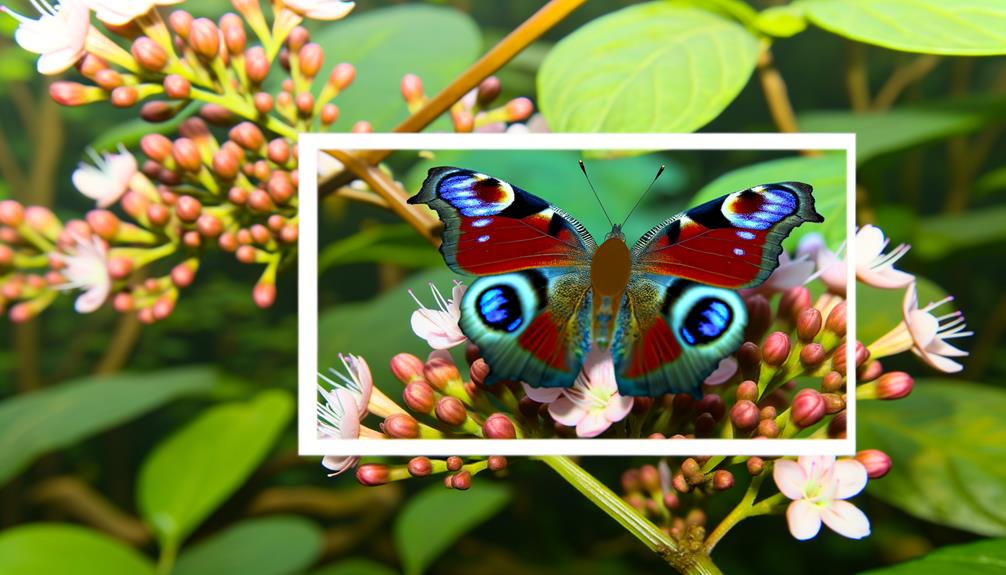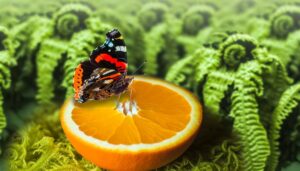Butterflies Similar to the Red Admiral: Top 5 Look-Alikes
Butterflies similar to the Red Admiral (Vanessa atalanta) include species such as the Painted Lady (Vanessa cardui), known for its vivid orange and black coloration, and the Mourning Cloak (Nymphalis antiopa), which features dark maroon wings with blue spots and yellow edges. The Peacock Butterfly (Aglais io) is distinguished by its eye spots, while the Comma Butterfly (Polygonia c-album) has distinctive ragged edges and a white 'C' mark.
The Tortoiseshell Butterfly (Aglais urticae) sports vibrant orange and black patterns with scalloped edges. These species, all within the Nymphalidae family, share similar habitat preferences and survival strategies.
More intriguing details await.

Key Takeaways
- The Painted Lady displays similar vivid orange and black hues and has a comparable wingspan to the Red Admiral.
- The Tortoiseshell butterfly shares vibrant orange and black patterning with scalloped wing edges, resembling the Red Admiral's appearance.
- Mourning Cloak butterflies exhibit territorial aggression and sun basking behaviors like the Red Admiral.
- The Comma butterfly is similar to the Red Admiral in its use of camouflage and territorial displays.
Painted Lady

The Painted Lady (Vanessa cardui), a member of the Nymphalidae family, exhibits striking morphological similarities to the Red Admiral (Vanessa atalanta) with respect to wing pattern and coloration. Both species showcase vivid orange and black hues, characterized by intricate patterning.
Vanessa cardui, however, is distinguishable by its unique mottled brown and white patches on the hindwings. This species has a cosmopolitan distribution, inhabiting diverse ecosystems worldwide.
The Painted Lady's wingspan ranges from 5 to 9 centimeters, slightly larger than that of the Red Admiral. Larvae of Vanessa cardui primarily feed on thistles, which influences their habitat selection.
The adult butterflies are known for their long migratory patterns, making them prominent subjects in ecological and evolutionary studies.
Mourning Cloak
The Mourning Cloak (Nymphalis antiopa) exhibits distinctive wing patterns characterized by dark, velvety maroon wings bordered with pale, yellowish edges and iridescent blue spots, distinguishing it from the Red Admiral.
This species thrives in a variety of habitats, including deciduous and mixed woodlands, suburban areas, and riparian zones.
Its wide geographic distribution and adaptability to different environmental conditions make it a fascinating subject for comparative ecological studies.
Distinctive Wing Patterns
Mourning Cloak butterflies (Nymphalis antiopa) exhibit distinctive wing patterns characterized by their deep maroon coloration bordered by an elegant band of pale yellow and iridescent blue spots.
This unique combination of colors serves multiple functions, including camouflage and predator deterrence. The maroon base color, often appearing almost black in certain light conditions, provides effective concealment against tree bark and leaf litter.
The pale yellow edge and blue spots create a striking contrast, potentially confusing predators through disruptive coloration. The wing margins are scalloped, adding to the irregular pattern that breaks up the butterfly's outline.
This complex interplay of colors and shapes exemplifies the intricate evolutionary adaptations within the Nymphalidae family, enhancing survival and reproductive success.
Habitat Preferences
Nymphalis antiopa, commonly known as the Mourning Cloak butterfly, primarily inhabits temperate deciduous forests, riparian zones, and wooded areas.
This species demonstrates a marked preference for habitats with abundant moisture and host plants, such as willows (Salix spp.), elms (Ulmus spp.), and poplars (Populus spp.), which are essential for larval development.
The Mourning Cloak exhibits a unique overwintering strategy as adults, often seeking refuge in tree cavities, under bark, or within human structures.
This hibernal diapause allows them to emerge early in spring, coinciding with the availability of sap flows and early blooming flora.
Such habitat specificity underscores their ecological niche and adaptive behaviors, ensuring survival and reproduction across various temperate regions.
Peacock Butterfly

The Peacock Butterfly (Aglais io) is distinguished by its vibrant color patterns, featuring iridescent eye spots on each wing that serve as a predator deterrent.
This species primarily inhabits temperate regions across Europe and Asia, favoring environments that range from woodlands to gardens.
Behavioral traits of Aglais io include its remarkable ability to produce a hissing sound when threatened, a defense mechanism uncommon among Lepidoptera.
Vibrant Color Patterns
Exhibiting strikingly vibrant color patterns, the Peacock Butterfly (Aglais io) features iridescent eye spots on its wings which serve as a defense mechanism against predators.
These eye spots, located on both the forewings and hindwings, mimic the eyes of larger animals, deterring potential threats.
The upper side of the wings is primarily a deep, rich red, contrasted by black and blue markings. The hindwings are adorned with distinctive blue and yellow eye spots, enhancing the butterfly's deterrent effect.
This coloration not only serves a protective function but also plays a role in thermoregulation, aiding the butterfly in absorbing sunlight.
The Peacock Butterfly's vibrant patterns are a fascinating example of evolutionary adaptation and species-specific defensive strategies.
Habitat and Range
Renowned for its iridescent eye spots and vibrant coloration, the Peacock Butterfly (Aglais io) mainly inhabits temperate regions across Europe and Asia, thriving in a variety of environments including woodlands, gardens, and meadows.
This species exhibits a remarkable adaptability to diverse ecological niches, ranging from lowland areas to montane habitats.
The larval host plants mainly include species of the genus Urtica, particularly Urtica dioica (stinging nettle).
Seasonal migrations are minimal, as the Peacock Butterfly engages in overwintering as an adult, utilizing sheltered locations such as tree hollows and man-made structures.
Its geographical distribution extends from the British Isles eastward to Japan, indicating a broad range of climatic tolerance.
This adaptability guarantees its persistent presence across varied landscapes.
Behavioral Characteristics
Behavioral intricacies of the Peacock Butterfly (Aglais io) reveal a species adept at both defensive tactics and territorial displays, often utilizing its striking wing patterns to deter predators and assert dominance.
Aglais io exhibits multifaceted behaviors to guarantee survival and reproduction. The conspicuous eyespots on its wings serve as a primary deterrent against avian predators. Such visual deception is complemented by auditory signals produced through wing-rubbing, further disorienting potential threats.
The territoriality of Aglais io is evident as males aggressively patrol and defend their chosen habitats to secure mating privileges.
Noteworthy behavioral attributes include:
- Eyespot Display: Startling predators with sudden wing openings.
- Auditory Defense: Creating hissing sounds to confuse threats.
- Territorial Aggression: Males fiercely protect their domains.
These behaviors underscore the complexity of Aglais io's survival strategies.
Comma Butterfly
The Comma Butterfly (Polygonia c-album) is a member of the Nymphalidae family, characterized by its distinctive ragged wing edges and a white 'C' shape on the underside of its hindwings.
This species exhibits remarkable polymorphism with its angular wings, which provide effective camouflage against predators. The dorsal side of its wings displays a vibrant orange-brown with dark spots, enhancing its visibility in flight. In contrast, the ventral side appears mottled brown, mimicking dead leaves.
P. c-album thrives in temperate regions across Europe and Asia, primarily inhabiting woodland edges and hedgerows. The larval host plants include nettles, elm, and hops, facilitating its widespread distribution.
Understanding its ecological preferences and morphological adaptations underscores its resilience and evolutionary success.
Tortoiseshell Butterfly

Among the array of butterflies similar to the Red Admiral, the Tortoiseshell Butterfly (Aglais urticae) stands out with its strikingly vibrant orange and black patterning, belonging to the family Nymphalidae.
This species exhibits remarkable adaptability across various habitats, from meadows to urban gardens. The Tortoiseshell Butterfly is distinguished by its scalloped wing edges and the presence of blue spots along the periphery of its hindwings.
Noteworthy features include:
- Coloration: The vivid contrast between orange and black, with blue spots, evokes a sense of awe.
- Behavior: Known for their territorial aggression, they defend their feeding grounds vigorously.
- Lifecycle: Their larval stage primarily feeds on nettles, essential for their development and population sustainability.
This butterfly's resilience and beauty make it a fascinating subject for both researchers and enthusiasts.
Red-Spotted Purple
Characterized by its iridescent blue-black wings adorned with red and white spots, the Red-Spotted Purple (Limenitis arthemis astyanax) belongs to the family Nymphalidae and is a compelling example of mimicry within the Lepidoptera order. This butterfly mimics the toxic Pipevine Swallowtail (Battus philenor) to deter predators, an evolutionary strategy known as Batesian mimicry. The Red-Spotted Purple is primarily found in the eastern United States and thrives in deciduous forests and urban areas.
| Feature | Description |
|---|---|
| Wingspan | 7.5–10 cm |
| Habitat | Deciduous forests, urban regions |
| Diet | Nectar, rotting fruit, tree sap |
Its lifecycle includes egg, larval, pupal, and adult stages, with larvae feeding on various host plants such as willows and poplars.
Conclusion
To sum up, the examination of butterflies similar to the Red Admiral (Vanessa atalanta) reveals a fascinating array of species, including the Painted Lady (Vanessa cardui), Mourning Cloak (Nymphalis antiopa), Peacock Butterfly (Aglais io), Comma Butterfly (Polygonia c-album), Tortoiseshell Butterfly (Aglais urticae), and Red-Spotted Purple (Limenitis arthemis). These butterflies share various characteristics with the Red Admiral, such as vibrant coloration, wing patterns, and habitat preferences. Observing butterflies similar to Red Admiral can provide valuable insights into their adaptive strategies, migration behaviors, and ecological roles. Their striking appearances and fascinating behaviors make them a delight for both researchers and nature enthusiasts alike.
These species, akin to gems in a biological treasure chest, exhibit diverse morphological traits and ecological niches, enriching the Lepidoptera family's evolutionary tapestry.






